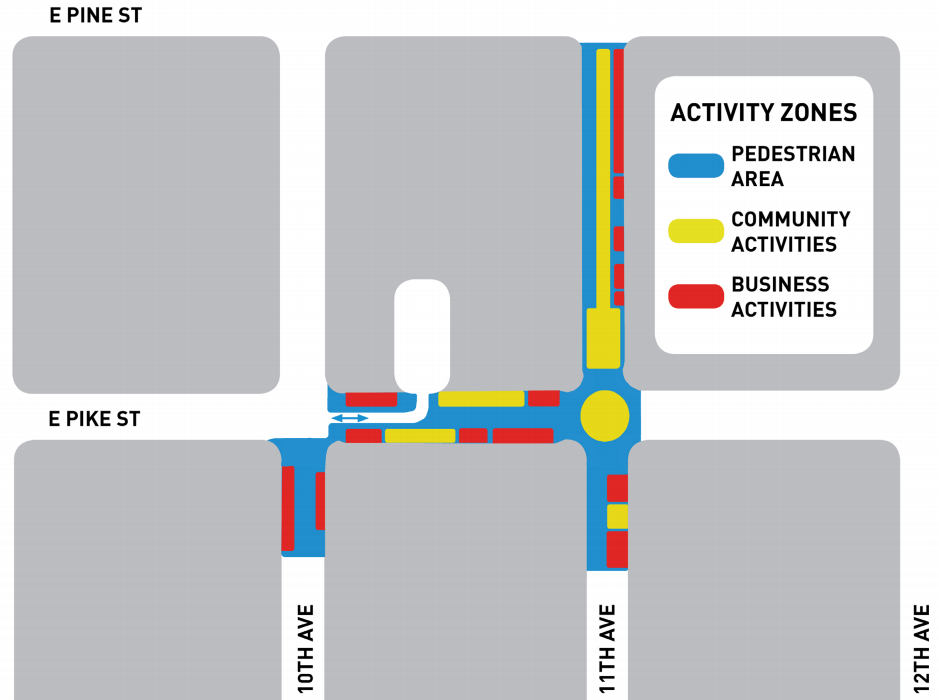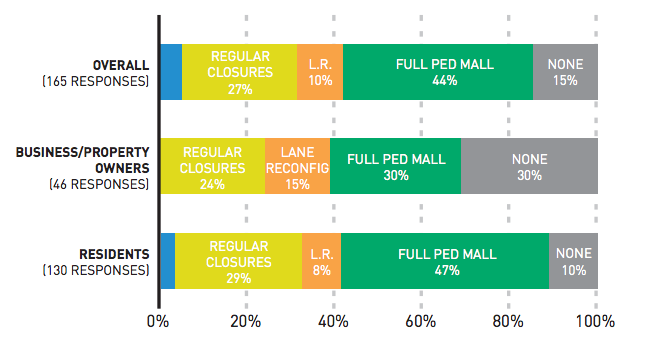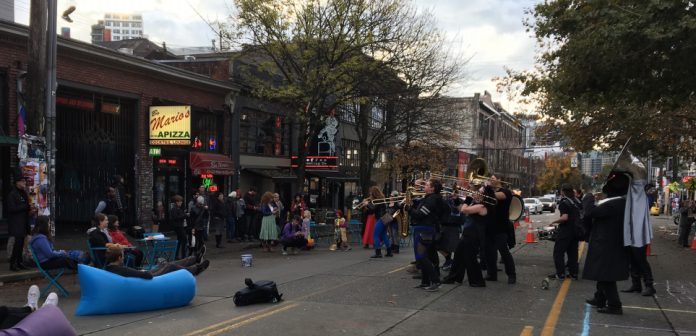For the past two years, the Seattle Department of Transportation (SDOT) has attempted to try out an idea that works well in high-volume pedestrian-oriented nightlife districts: closing a central street to vehicles during the peak weekend hours. This gives pedestrians more space when more people are out, and more people have been drinking. E Pike St between Broadway and 12th Ave has particularly narrow sidewalks, with cafe tables and benches turning the sidewalk edge into a lively but crowded space.
It has been this stretch that SDOT has focused their pilots for a “people street”, with mixed success. The 2015 and 2016 test runs were sporadic: testing only occurred on three weekend nights in August of 2015 and in 2016 there was only one late-night test done in October and one weekend afternoon test, followed by a final test during the art walk in December. The configurations of the pilots all varied: on some nights, cross traffic was allowed through at 10th Ave and 11th Ave, requiring pedestrians to cross at the intersections and on other nights it wasn’t.

The feedback SDOT heard about the closures was: do more of them! The most popular reason survey respondents in 2016 said they didn’t like the program was that they were too infrequent. Well, the City is listening. In 2017, the Pike People Street is returning for 10 days: two Thursday art walk nights in July and August and eight Saturday nights during those months. And the street configuration will be the same every time: full closure of 11th Ave between E Pike St and E Pine St, and almost-full closure of E Pike St between 11th Ave and 12th Ave, with the exception of access to the Poquito’s parking lot. The closure will also spill onto 10th Ave and 11th Ave south of E Pike St.
The Pike People Street program accomplishes a number of things:
- It alleviates pedestrian congestion which is a real problem in this stretch of Capitol Hill;
- It encourages public safety by allowing more choices for avoiding street harassment or even violence; and
- Reduces conflicts between drivers and pedestrians at a high-tension time of night.
In addition, SDOT is encouraging the activation of the space with both community-led and business-led activities. The Pike/Pine retail corridor is one of the most dense in the city, and also one of the most impacted by large events like the Capitol Hill Block Party or May Day protests. Events like the People Street should bring people to their door, not discourage people from coming, and the People Street program will allow businesses to activate the space outside their establishment how they would like to.
Another question in SDOT’s 2016 survey asked people “What type of pedestrian street closures would be most appropriate for Pike/Pine in the future?”

A full 47% of the Capitol Hill residents and 44% overall said that they’d like to see Pike Street turn into a permanent pedestrian mall. Seattle does not currently have any pedestrian-and-bike-only corridors near Downtown. Last year, I wrote about the People Street and suggested turning the parking lane into a sidewalk extension as a compromise. Any way to improve this congested stretch of Capitol Hill sidewalk would be welcome. We’ll see you on Pike Street in July and August!
You can learn more about the People Street on SDOT’s page for the concept.
Ryan Packer has been writing for The Urbanist since 2015, and currently reports full-time as Contributing Editor. Their beats are transportation, land use, public space, traffic safety, and obscure community meetings. Packer has also reported for other regional outlets including BikePortland, Seattle Met, and PubliCola. They live in the Capitol Hill neighborhood of Seattle.


